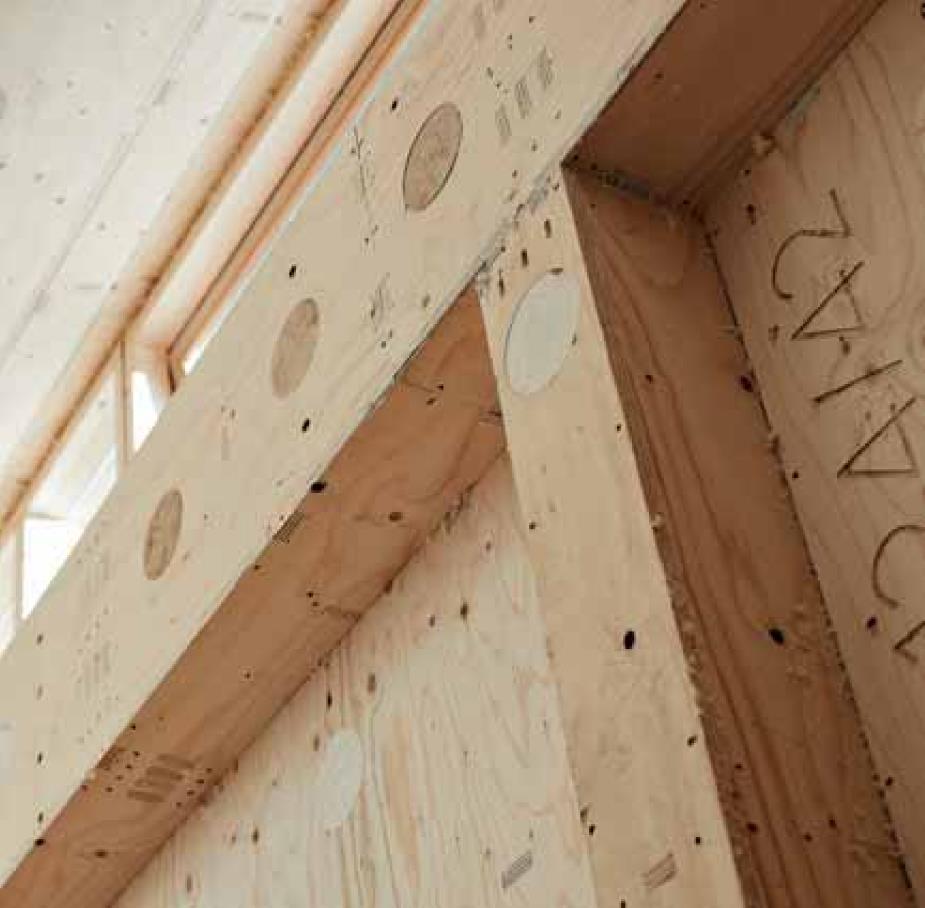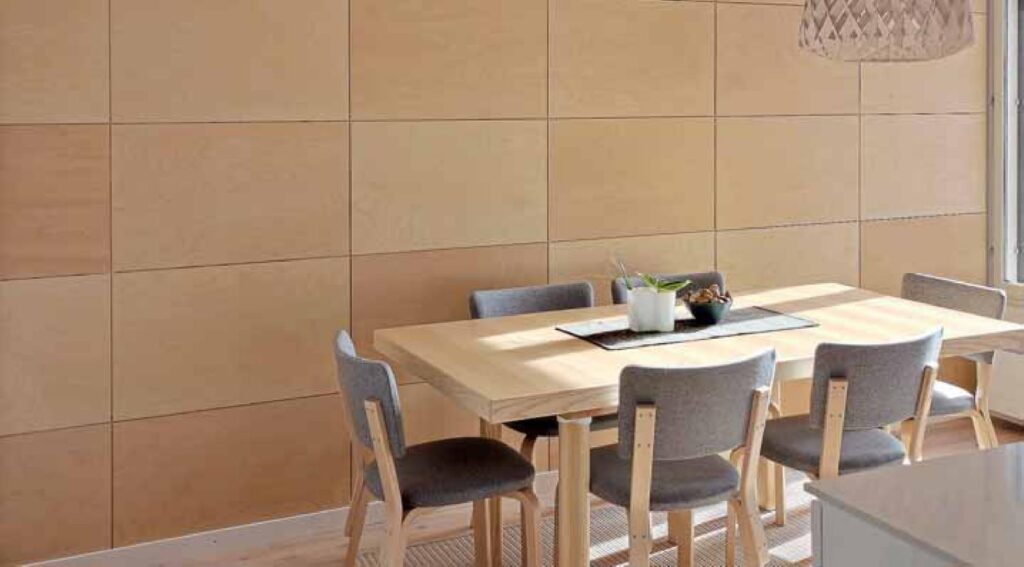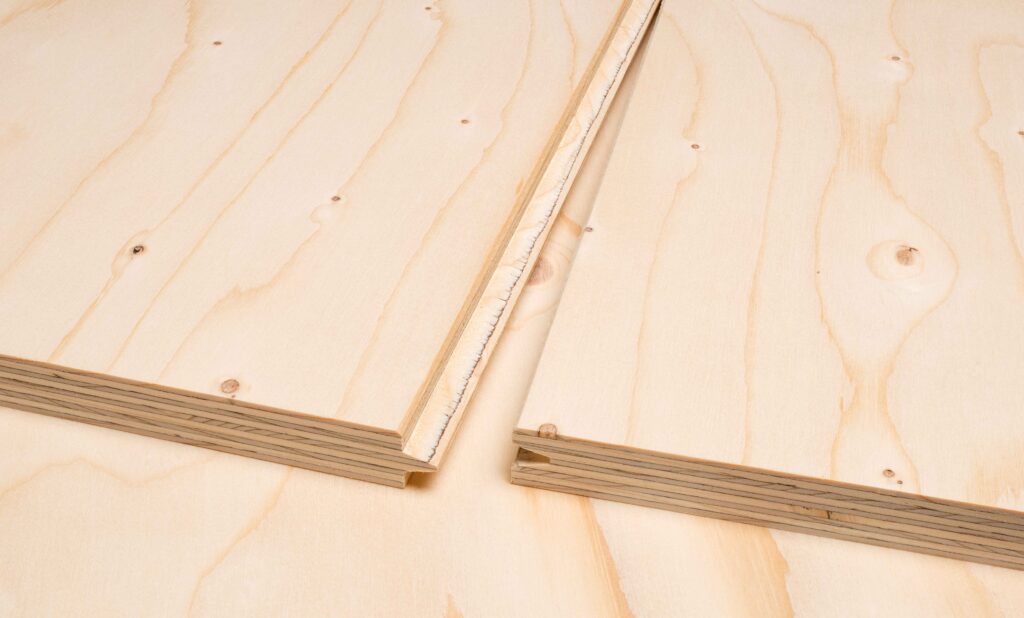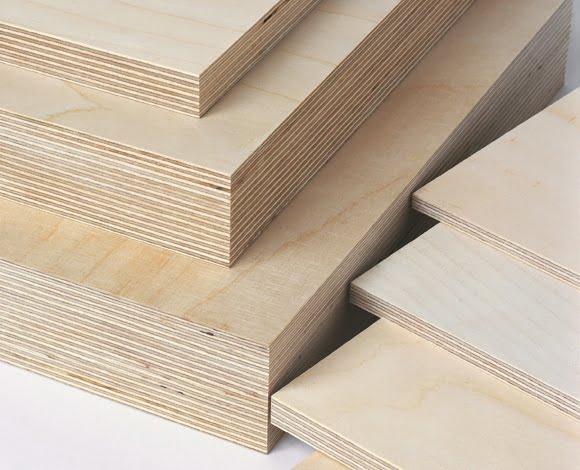Plywood
Plywood is made by glueing together thin sheets of wood veneer. The thickness of an individual sheet is 0.2 – 3.2 mm. The sheets are composed so that the directions of the grain of the superimposed sheets are usually perpendicular to each other. In birch plywood board, there is usually an odd number of sheers (at least three), so the direction of grain of the surface sheets is always the same. In conifer plywood sheets, the number may also be even. In glueing, weather-resistant phenolic resin adhesive is normally used. In terms of colour, it is considerably darker than veneering wood.
In terms of its basic properties, plywood is comparable to wood. It also has the following benefits, owing to its method of manufacture:
- strength, good at providing rigidity for structures
- dense and shock-resistant
- multi-purpose
Some plywood products are classified in surface material emissions class M1. Material classification includes the limit values for the emissions of building materials meant for interiors, as well as their classification. Class M1 contains emissions-tested materials, whose emissions of impurities are within the most stringent requirements.
Standard thicknesses of plywood boards. Maximum manufacturing thickness is 50 mm. | ||||||||||
Type of plywood | Nominal thickness mm | |||||||||
Birch and conifer plywood | 4 | 6.5 | 9 | 12 | 15 | 18 | 21 | 24 | 27 | 30 |
Mixed plywood | - | 6.5 | 9 | 12 | 15 | 18 | 21 | 24 | 27 | 30 |
Basic plywoods
Basic plywood can be divided into three main categories: birch plywood (density approx. 680 kg/m³), mixed plywood (density approx. 620 kg/m³) and conifer plywoods (density 460-520 /m³).
Birch plywood is used in applications requiring great strength or high quality, such as in special flooring and demanding interior linings.
Mixed plywoods are multi-purpose general plywoods. They are used, for example, as basic boards and concrete moulds for downstream products and special plywoods. Because the surface of mixed plywoods is always birch, they are in the same quality classes as birch plywoods.
Mixed plywoods are:
- Combi – two veneers of birch on both surfaces, internal veneers alternating birch and conifer
- Mirror image combi – surface veneers birch, internal veneers alternating conifer and birch
- Twin – surface veneers birch, internal veneers conifer
Conifer plywoods are particularly used in construction, for example in roof structures and interior linings. They are mostly made of spruce.
Plywood quality classes
The choice of quality class of birch veneer-surfaced plywoods according to application (in brackets, the other generally used quality class) is presented in the table below.
Birch veneer-surfaced plywoods | |
A (E) | Flawless special quality (only available to a limited extent) |
B (I) | Lacquered or waxed surface |
S (II) | Paintable surfaces |
BB (III) | Normal quality, for example under coverings, the most common quality in structures |
WG (IV) | For less demanding applications, a quality that cannot be repaired |
The choice of quality class of conifer plywoods according to application is shown in the table below.
Conifer plywoods | |
E | Flawless quality, only pine-surfaced |
I | Almost flawless quality, only pine-surfaced |
II | Downstream quality with an intact surface |
III | Non-repairable quality for construction |
IV | Non-repairable quality for construction (background surface quality) |
Uncoated downstream products made of basic plywood
Examples of downstream products made of basic plywood meant for construction are:
- 9 m wall board
- 18 mm all-round tongued and grooved subfloor board
- 15 mm board tongued and grooved on the long sides meant as a roofing substructure
Wall board (board size 1,200 x 2,750 mm, nominal thickness 9 mm) is non-tongued and grooved and meant as a base plate to increase the strength and rigidity of boarding on internal walls, and in so-called double-plated walls, where other interior lining material is used as inner lining on top of plywood. The dimensions of the board are suitable for the most common 400 mm and 600 mm frame column spacings.
Subfloor board (board size 2,400 x 1,200 mm installed on tongues and grooves, nominal thickness 18 mm) is all-round tongued and grooved, and meant as a load-bearing structural board for floors that are supported on a podium. Its thickness and dimensions are suitable for 400 mm and 600 mm beam spacings.
Roof substructure board (board size 2,700 x 1,200 mm, nominal thickness 15 mm) has a special structure, is tongued and grooved on its long sides and especially meant as a load-bearing substructure for felt- and sheet-metal roofs when the distance between the roof supports is 900 mm. Compared to traditional rough tongue and groove boarding, plywood boarding can achieve significant savings in total working hours and an even and structurally rigid substructure. The board can also be used as a load-bearing substructure in floors. The boards are mainly for protection against moisture during construction.
With regard to other uncoated downstream products made of basic plywood, grooved and semi-tongued and grooved interior board (board size 2,500 x 1,210 or 610 mm, thicknesses 7.5 and 10 mm) should also be mentioned. This is meant for the lining and semi-panelling of interior walls and ceilings, and is used in the manner of interior lining boards. Interior boards are made of conifer plywood with a spruce veneer surface, and their visible surface is grooved at longitudinal 75 mm intervals with W-shaped grooves. The long sides are semi-tongued and grooved.
Special plywoods
Special plywoods are chiefly basic plywoods made for a specific purpose in standard dimensions and coated in different ways, depending on the application. Coating can improve the wear-, shock-, weather- and chemical resistance of the plywood as well as its friction properties. Coated plywoods are usually edge-protected with coloured edging paint. Edge protection done at the factory is meant to protect against moisture during storage, and must always be redone, if the board is put in a location in which moisture protection is needed.
Examples of coated plywoods
Film plywood or moulding plywood are amongst the best-known and most used types of coated plywood. For the basic board, birch, mixed and conifer plywoods are all used, which are usually coated on both sides with a smooth and durable phenolic film, the colour of which is normally dark brown. This kind of plywood is used in concrete moulds, means of transport and as interior lining board in agricultural buildings.
The thicknesses of the board vary from 6.5 to 30 mm. The standard widths are 1,200, 1,220, 1,500 and 1,525 mm, and lengths vary between 1,200 and 3,660 mm. In addition to the above-mentioned brown film, special colours are also available. They are not, however, recommended for concrete moulds.
Plywood coated in primer paint is a board meant for use in facade boarding that requires painting, vehicle bodywork, traffic signs, advertising hoardings, etc. Birch and mixed plywood are used as the basic board, and coated on both sides with phenol-based primer paper (light brown), and the background surface can alternatively be coated with phenolic film. Boards are also available ready primed.
The thicknesses of the board vary from 6.5 to 30 mm. The standard widths are 1,200, 1250, 1,500 and 1,525 mm, and lengths vary between 2400 and 3,660 mm. The boards can be painted with normal exterior paints (primer + 2 surface coats) or with special paints (2 x epoxy-based paint and 1 x polyurethane paint on the surface). The boards’ edges are protected by painting as on the surfaces. The surface of plywood that has been painted does not suffer from hairline cracks, which usually gradually form on the painted surface and surface veneer of uncoated plywood.
Flame retardant treated plywood
Plywood can be treated with a flame retardant, so its fire resistance increases. The surfaces are processed at the factory. Flame retardant treated plywood is suitable for structural applications, since the treatment does not affect the plywood’s technical properties.
Other special plywoods
Other special downstream or machined plywood products include
- scaffolding boards – coated with phenolic film, on which an anti-slip pattern is printed or other so-called wire pattern
- balcony floor board – coated to withstand weather and sunlight.
The use of plywood as a part of frame structure
- wall board in double-boarded walls – stiffens the wall structure
- roof substructure – stiffens the roof structure
- subfloor board – stiffens the horizontal structure
Interior lining
Examples of interior lining
- wall lining
- half-wall panelling
- ceiling lining
Plywoods suitable for interior lining:
- all basic plywoods (quality class is selected based on surface treatment, mainly classes E, I and II)
- downstream plywood products meant for interior lining
Matters to be taken into account in interior lining:
- From a point of view of fire regulations, plywood is particularly suitable for interior lining in houses (for P3 fire class buildings). In most cases, it can also be used in the interior lining of residential, office and public buildings, etc.
- In dry interior spaces, the moisture dynamics of plywood are slight. It is advisable to make the joints between the boards as exposed joints (1-3 mm). The joints can be covered with batten strips, if necessary.
In the installation of wall boards, the recommended board thicknesses and distances between supports are:
- 6.5-9 mm, when the distance is no more than 300 mm
- 9-12 mm, when the distance is no more than 600 mm
In ceiling lining, the recommended between fastening supports is no more than 400 mm.
The boards are fastened with nails or screws, with a length 2½-3 times the thickness of the board.
Ordering
When ordering plywood boards, the following information should be given:
- use
- thickness as a nominal thickness (mm)
- size of the board with the measurement of the surface veneer in the direction of the grain always mentioned first (mm x mm)
- type of plywood (e.g. combi)
- qualities of both surfaces, the visible surface always mentioned first/e.g. S/WG = II/IV)
It is also possible to order plywood made-to-measure, perforated, with additional or special machining, etc.
Storage
During transportation and storage, the boards are protected from wetness, dirt, ground contact, sunlight, dents and scratches. The boards are stored face down on a flat base. If necessary, supporting timber is used at intervals of 0.5 metres. Storing the boards vertically should be avoided. Any steel strapping around the pile of boards must be removed if the plywood is to be stored in damp conditions. The pile of boards is covered with a protective sheet. Storage conditions should be similar to the conditions in which the boards will ultimately be used. Before installation, the plywood must be aired for 3-8 days in conditions close to those in which it will ultimately be used.
Working and machining
Plywood’s moisture dynamics of 1 mm/1m of plywood must be taken into account when installing it.
Sawing
A table-mounted or portable circular saw, for example, is suitable for sawing the boards. Smaller sawing jobs can also be done with a regular hand saw. Contour sawing can be done with a jig saw. A board sawn according to the direction of movement of the blade is installed so that fraying of the surface veneer caused by the sawing (especially sawing across the grain of the veneer) takes place at the rear surface of the board that remains hidden. For example, when using a portable circular saw (rotary saw), it is advisable to place the board’s visible front surface downwards.
Perforation
If necessary, plywood boards used in interior lining can also be ordered ready perforated. Perforated boards are normally used for reasons of acoustics or appearance. Perforation is done mechanically and, when ordering the boards, in addition to the above-mentioned instructions, the hole size and gap between the holes should also be mentioned. The hole size may be, for example, ø 6, 8, 10, 12… mm and the distance between the holes 16, 32, 64….mm. Some suppliers might have certain standard hole sizes and distances, so it is advisable to check the perforation alternatives before ordering.
Bending
Curved surfaces can also be made with plywood. Thin boards less than 10 mm thick are most suitable for this purpose. The indicative bending radius is slightly less than one metre, with the bending taking place across the direction of grain of the surface veneer and the thickness of the board no more than 9 mm. You should be aware that a small bending radius causes the surface of the board easily to suffer hairline cracks. A bent board is always fastened with screws.
The smallest bending radii of plywood. Water- or steam treatment helps in the bending of plywood. Birch veneer-surfaced mixed plywood. | ||
Nominal thickness mm | Bending in the direction of grain of the surface veneer | Bending across the direction of grain of the surface veneer |
6.5 | 850 | 650 |
9 | 1150 | 950 |
12 | 1150 | 1250 |
Fastening
The length of nails used to fasten the boards should be at least three times the thickness of the board, but no less than 30 mm, and the length of screws at least 2½ times the thickness of the board, but no less than 25 mm. When nailing, it is advisable to use profiled nails and, in installing base plates for roofs, hot-galvanised screws or nails.
The boards are fastened at intervals of about 150 mm on each side and about 300 mm at the centre. Fasteners that will not be left visible are fastened to plywood boards at an average of 10 mm from the edge of the board. Fasteners that will be left visible are fastened to the plywood boards at a distance of 10 mm from the edge of the board, in a straight line and facing each other on both sides of the joint.
When plywood is used as part of frame structures (usually tongued and grooved conifer plywood), the adjacent boards are installed so that the board joints do not form a crosswise pattern.
Surface treatment
Uncoated (veneering wood-surfaced) plywood can be surface-treated with normal paint products meant for wood lining. Priming must be done with special care to prevent possible surface cracks. In order to avoid hairline cracks on the surface, use plywood that has been ready-treated with epoxy primer or coated with primer paper. When painting coated plywood, it is advisable to apply two coats of epoxy primer and one coat of polyurethane paint for the surface.
Because products meant of surface treatment have considerable differences depending on the manufacturer, the product’s suitability to plywood surfaces must always be checked from the manufacturer’s instructions.
The surface treatment of interior lining boards mainly has aesthetic significance. Covering painting, glazing colouring, staining, etc. gives the plywood the desired colour, whilst colourless lacquer mainly gives the desired degree of gloss. Furthermore, surface treatment makes it easier to keep the plywood lining clean.
In interior spaces, the following are suitable for the surface treatment of plywood lining:
- waxing (colourless or coloured)
- lacquering (colourless or coloured stain lacquer)
- painting (all the most common products meant for interior wood surfaces)
Before treatment, it is advisable to sand the surface lightly (particularly waxable surfaces). In dry facilities, plywood can also be used without surface treatment. In a technical sense, ceiling lining in particular does not usually necessarily require surface treatment. It is, however, good to be aware that UV radiation from sunlight gradually causes top veneer to darken, which can to some extent be prevented with lacquer containing a UV-protective agent. On the other hand, lacquering in itself may cause the top veneer to change shade (usually more yellow). This can be prevented by using lacquer mixed with a small amount of white pigment. The above-mentioned changes in shade and their strength vary depending on the type of wood that the top veneer is made of.
The re-use and disposal of plywood
Re-use
If the boards are intact and dry and the adhesive from the veneer joints has not separated, plywood boards may be used again on a case-by-case basis. Re-use is the most popular was of ’disposing of’ plywood products.
Burning
Small quantities of uncoated or film plywood can be disposed of by burning with other wood. The temperature should be so high that burning takes place as perfectly as possible.
Composting
Basic plywoods and most special plywoods can also be composted. Plywood waste mixed with waste wood chips facilitates the composting process. Fairly large amounts of plywood waste can be taken to landfill.
Plywood applications
Construction
- roof substructures
- subfloor boarding
- stiffening boarding for wall and load-bearing structures
- interior lining
- balcony floors
- scaffolding platforms
- concrete moulds
- building site fences
Construction industry
- as web plates for beams
- substructure for boarded parquet floor
- fixtures and fittings
Means of transport
- containers
- trailers
- van interiors
- railway carriages
Shipbuilding
- cargo ship linings
- car decks
- hatches
- interior decoration
Other applications
- furniture, the carpentry industry and small objects
- equipment for the food industry
- packaging
- traffic signs and advertising hoardings
- auditorium/stadium structures
- exhibition and fair structures
- ice rinks
- speaker cabinets



